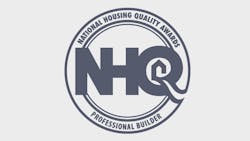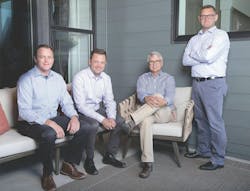It’s All About the Feedback: 2020 National Housing Quality Award Winners
Thrive Home Builders
2020 Silver Award winner
NHQ Silver Award winner Thrive Home Builders was on the continuous improvement track well before submitting its first NHQ Award application in 2018, yet being judged by fellow builders was still an epiphany for the Denver builder, even the second time.
“Nothing brings your shortcomings into sharper focus like a peer review,” says founder and CEO Gene Myers.
That’s the sentiment from a leader whose company had already been deep into a LeanBuilding Blitz with consulting firm TrueNorth Development. That partnership uncovered waste in design and construction practices, worked with trade partners to simplify processes, and tracked key performance indicators. Yet last year, NHQA judges, though scoring the company high enough to win Bronze, called out Thrive for its high employee turnover and substandard customer satisfaction scores.
Thrive acted on those recommendations, including providing its trade partners with more feedback and sharing metrics regarding warranty performance and customer satisfaction with them. Managers also invited each trade partner to tell them what it was really like to work on a Thrive project. They were told over and over that their jobsites were neither work-ready nor work-clean.
“It was a pretty humbling experience,” Myers says. “We’ve been so quick to blame our trades, the trade shortage, the labor environment, but we actually were making it difficult for our trades. If we wanted to point the finger, we could almost always point it back at us in some way.”
To address the issue, Thrive set up a vendors council, made up of nine subcontractors and four employees, that meets monthly about jobsite efficiency. The members collaborated and created job-ready/job-complete checklists for every trade partner that works with Thrive. When TrueNorth surveyed those trade partners this past January on how the company had improved toward the goal of becoming a builder of choice, Thrive scored above the national mean in all six categories after having been under those metrics the previous year. TrueNorth president Scott Sedam deemed the turnaround the biggest year-to-year score improvement he’s seen in 10 years of conducting the survey among more than 75 builders nationwide.
Myers credits the inroads made with trade partners as one of the more valuable insights gleaned from the NHQ process. Strengthening those relationships, coupled with working on areas for improvement identified through the LeanBuilding exercise and reaping efficiencies from software investments, resulted in other downstream benefits, such as reducing building cycle time from 32 days in 2017 to 28 days last year, with a target of 20 days for 2019. And as Thrive delivered houses complete and on time, it helped boost customer satisfaction scores.
“You start moving the meter on your build time, then the ripple affects your bottom line [and] your customer satisfaction,” Myers says. “And your trades are helping you get there.”
This year, NHQ judges lauded Thrive for the high level of employee engagement and their passion for the cause and the culture. But they again knocked the company for high employee turnover during the last three years. Myers admits that management was still in a recession mind-set regarding compensation as the market rebounded, and competitors outbid Thrive for construction team members.
“I never worked for another builder, so I don’t know how to benchmark against other builders and best practices,” Myers says. “Our team came from other places, and their practices aren’t always best practices, so what you’re getting with NHQ is the best builders in the country to show up at your shop for two days and give you feedback from their vantage point. It’s not something we can replicate any other way.”
An additional turnover factor was the builder’s recent adoption of open-book management, a practice where management regularly shares the company’s financial performance, warts and all, with employees and teaches workers how the business makes a profit. Employees take ownership of reaching financial and performance targets and are given a stake in the outcome with profit sharing and bonuses.
Another open-book management practitioner, Keith Porterfield, COO of Goodall Homes, a Berkshire Hathaway company in Gallatin, Tenn., and a 2018 NHQ Silver Award winner, warned Myers that when you start internally publicizing performance, some employees will self-select their way out of the business.
“One result of open-book management is that just by providing honest transparency about what is happening in the company it shines a light on efficiency, and some people are uncomfortable with that,” Myers says.
Thrive has since improved compensation and benefits following feedback from an employee survey. The builder also uses software from Predictive Index to assess prospects and employees for their strengths in relation to specific positions and the company culture. In addition to a standard job interview, applicants experience a culture interview where they spend time with Thrive employees, not supervisors. Prospects ask employees what it’s like to work for their boss and the company, and employees weigh in with management about whether the candidate is a fit.
Once hired, the onboarding process includes the new employee being assigned a sponsor who takes that person to meet every employee and member of the executive and leadership teams over the first 30 days. New employees also attend a four-week class, taught by Myers and the vice presidents, based on “The Great Game of Business” by Jack Stack, who is considered the father of open-book management.
While turnover is still a struggle in the sales department, the exodus of construction employees stopped in 2018, and Thrive’s total head count ranges between 65 and 70 employees.
“My great hope is we end up with a core of people who believe in what we do and why we do it and stem the tide on turnover,” Myers says.
Thrive’s focus on being a data-driven organization was cited as a strength by NHQ judges but with the caveat that although a substantial amount of data was being collected, it did not appear all of it was being used in ways to improve the company.
The opportunities for improvement are there, and the judges recommended more effort be put into tracking variance purchase orders and analyzing their root cause. Also, even though the warranty cost per listing and average number of days to complete declined, warranty expenses per home are higher compared with industry metrics
Myers concurs with the judges’ comments, and Thrive has implemented software such as BuilderPro, SupplyPro, Punchlist Manager, and FTQ360 as a result. During the past two years, it has been engaged in debugging and then rolling out those apps to employees, and then to trade partners. “We laid the foundation, and what’s happening now is we are finally getting good data,” he says. “Now it’s time to put that to use. We are in a position for continuous improvement that is data driven.”
Thrive’s annual revenue increased 14% from 2017 to 2018 to $118.9 million while closings rose 20% to 252 homes. After having a consistent supply of finished lots over the past 18 years at Stapleton, a Colorado master planned community that is nearing completion, the company’s future includes expanding to Fort Collins, Colo., through a 500-unit project with a blend of infill and greenfield lots. There, Thrive will target “missing middle” buyers with five products: two townhome series, cottages, duplexes, and detached single-family homes. With that, the redeveloped Loretto Heights campus of the closed Colorado Heights University in Denver will feature Thrive as the only for-sale builder of more than 300 units. The builder also will continue to offer homes certified under the DOE’s Zero Energy Ready Home program as a competitive differentiator.
“It’s not one thing, it’s all things to get the flywheel turning,” says Myers about his commitment to getting better. “It’s an improvement, and it gets easier and easier to keep going once you get the momentum started.”
Garbett Homes
2020 Bronze Award Winner
Of all the metrics that a builder can track, perhaps the most significant is a homebuyer’s willingness to refer.
Bryson Garbett, president and CEO of Garbett Homes, retained customer satisfaction consultant Woodland, O’Brien & Scott five years ago to survey customers. The initial results were not very good. That feedback report, called the Voice of the Customer, was the genesis of a self-assessment journey for the Salt Lake City builder and eventually influenced Garbett to apply for the NHQ Award in 2014. The company didn’t even earn a site visit that year, but the judges’ feedback on its application, along with results from its customer satisfaction surveys, provided a continuous improvement road map.
During those five years, Garbett’s staff identified 41 areas requiring attention and worked on improving those concerns—to the point that the builder applied to NHQ again this year and earned not just a site visit, but a Bronze Award.
“I’m not sure everyone gave 100% effort the first time, but after we received the feedback and decided to work on things, everyone was on board and wanted to apply [for an NHQA],” Garbett says. “We went through that first feedback report correcting where we thought we needed to improve and then went through it again in detail to find what else we needed to work on.”
Since 2016, Garbett’s annual revenue has jumped 40.3% to $64.9 million last year while closings during the same period rose 52.8% to 165 units and net profit margin almost doubled to 10.3%. And that all-important “willingness to refer” score increased to 83% compared with 76% in 2016.
To get there, Garbett began developing processes by using plan-do-check-act (PDCA), a four-step model for implementing continuous improvement. The routine of checking and making adjustments reduced purchasing and building cycle times by 25% in the two years following the builder’s first NHQA application. A design review that fixed incomplete product designs also contributed to those gains. Garbett also implemented a technical plan review of new product designs where all sales, construction, and trade partners collaborate on and critique the plans.
Implementing BuildTopia software was another by-product of the builder’s initial NHQA experience. The project management tool helps Garbett assemble start packages with all the information the construction team needs for scheduling and purchasing. All internal departments and trade partners learned how to use the system, and the enhanced communication has cut down on dry runs.
“We found after getting the trades, sales, our construction managers, and accounting all on board that we have much more data we can use,” Garbett says. “Some of that data, like with our [variance purchase orders], we can now analyze to find where they’re happening, how much are they, where are the problem areas, and where can we improve.” He admits the company hasn’t fully leveraged BuildTopia’s potential, but says the next phase will automate purchase orders so trade partners can get paid upon completion instead of a traditional invoicing process.
Although the NHQA feedback report this year noted a need to work on formalizing PDCA so it’s more company culture than catch phrase, there is evidence that the practice of checking and adjusting was potent enough to bring about corrections as the wheels showed signs of detaching last year when sales jumped 50%. That growth put pressure on employees and distracted them from following through on fundamental practices, such as having homes clean and complete for move-in. Consequently, customer referrals declined. That drop triggered a review, and the builder committed to engaging with buyers through “Power Hours.” Each week, construction managers and sales reps contact every buyer by phone to provide updates and tell them what happens next. Slip-ups with addressing warranty issues and the selection process also were corrected, and customer referrals recovered.
“I show up myself every week to a Power Hour to tell our customers thanks for buying, and I see my construction manager talking to customers about their vacation. He knows they went on a trip. He knows their kids,” Garbett says. “It makes the process more enjoyable for the buyer, and we find that our people are more interested in building a better home because they don’t want to disappoint their friend.”









